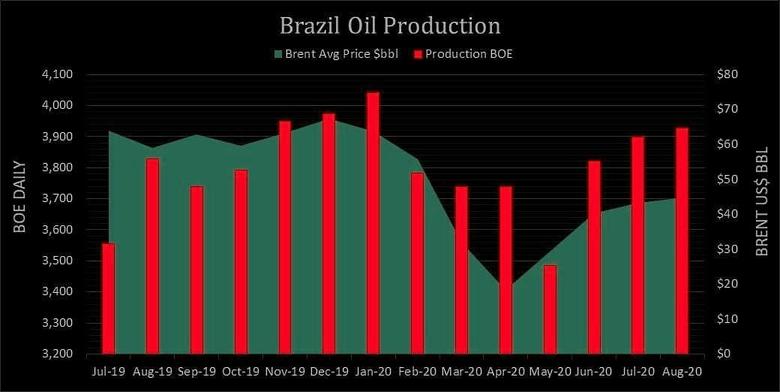
BRAZIL'S OIL GAS RECORD

PLATTS - 08 Jan 2021 - Brazilian state-led oil company Petrobras set a fresh record for annual output in 2020 on better-than-expected performance at the Buzios Field and improved corrosion-treatment efforts at its subsalt fields, the company said Jan. 7.
"The records demonstrate good operational performance despite the challenging scenario of 2020, with greater focus on world-class assets in deep and ultra-deep waters where Petrobras has displayed a large competitive advantage," the company said.
Petrobras pumped an average of 2.28 million b/d in 2020, beating the previous record of 2.23 million b/d set in 2015, the company said. Total oil and natural gas output also reached a record 2.84 million b/d of oil equivalent, which topped the previous record of 2.79 million boe/d also set in 2015, according to Petrobras.
The production record was a slight surprise given downward revisions the company made to its production forecast in the wake of coronavirus-related field shutdowns and output lost to asset sales. Petrobras had expected to end 2020 with oil production at 2.2 million b/d and total hydrocarbons output of 2.7 million boe/d.
Petrobras also planned a massive maintenance program in 2020 that was expected to shutter each major floating production unit installed in the subsalt for 15-20 days. The impact of the maintenance shutdowns was diluted by the coronavirus pandemic, with social-distancing measures limiting the size of onboard crews and causing delays.
The 2020 production record should be tough to beat, with Petrobras planning to shed an additional 600,000 b/d with the sale of fields, such as Albacora, Marlim, and most of the company's legacy onshore and shallow-water fields. Petrobras expects oil output to fall to 2.23 million b/d in 2021, with total hydrocarbons production also sinking to 2.75 million boe/d, according to the company's 2021-25 investment plan.
While Petrobras may be losing production with the divestment program, the quality of the company's output is climbing. That is because a greater share of Petrobras' production mix is coming from subsalt fields, which produce light oil that naturally contains low volumes of pollutants like sulfur.
Subsalt fields produced 1.86 million boe/d in 2020, accounting for 66% of Petrobras' total production, the company said. Subsalt fields represented just 24% of output in 2015, when the previous records were set, according to the company.
The Buzios Field, which pumped first oil in April 2018, was a major driver of output growth, Petrobras said. Petrobras made efficiency improvements that allowed the four floating production, storage and offloading vessels at the field to produce above their installed nominal capacity of 150,000 b/d, according to the company.
Petrobras also registered slower rates of decline at the Tupi and Sapinhoa fields, further demonstrating the robust productivity of the region's wells. Tupi, Buzios and Sapinhoa are Brazil's top-three production fields.
Efficiency improvements in subsea inspections and the use of reserve flow lines also reduced the number of interventions Petrobras needed to carry out to correct corrosion issues on subsea gas-injection lines, the company said. Despite the pandemic, Petrobras also became more efficient at carrying out FPSO shutdowns and optimizing production, the company said.
ENAUTA OUTPUT SINKS
Meanwhile, Brazilian independent oil and gas producer Enauta registered a sharp drop in fourth-quarter 2020 output after the company shut down the offshore Atlanta Field because of corrosion issues on Nov. 19. Enauta shuttered Atlanta in a preventive move after discovering corrosion in subsea equipment during inspections to replace faulty oil heaters, the company said at the time.
Atlanta pumped an average of 6,900 b/d in Q4, down from 28,500 b/d in the fourth quarter of 2019, Enauta said. Q4 output was also down from 14,000 b/d in the third quarter of 2020, company data showed.
Enauta previously reduced its 2021 production forecast Nov. 11 because of technical issues with water treatment onboard the FPSO at the field. Atlanta is expected to produce about 16,000 b/d in 2021, according to Enauta.
Atlanta produces crude having a gravity of 14-16 API that is highly viscous and needs to be heated to be pumped to the surface. The oil naturally contains about 0.5% sulfur content, which makes it a desirable target for processing into ultra low sulfur diesel and low sulfur bunker fuel by global refiners.
-----
Earlier:

2020, December, 2, 14:15:00
BRAZIL'S RENEWABLE 9 GIGAWATT
Brazil’s Northeast region concentrates the largest number of wind parks in the whole country thanks to its favourable conditions.
|

2020, October, 1, 13:25:00
BRAZIL'S NUCLEAR FUEL
The deposit - located in the interior of the state of Ceará - is the largest discovered uranium reserve in Brazil. An estimated 142,200 tonnes of uranium is inter-mixed with phosphates. The deposit has exploitable reserves of 79.5 million tonnes of ore, at grades of 11% P2O5 and 0.0998% U3O8, equating to about 8.9 million tonnes of P2O5 and 79.3 thousand tonnes of U3O8.
|

2020, June, 3, 12:40:00
BRAZIL'S PETROLEUM PRODUCTION 3.7 MBD
Companies operating in Brazil pumped 3.738 million b/d of oil equivalent in April
|








